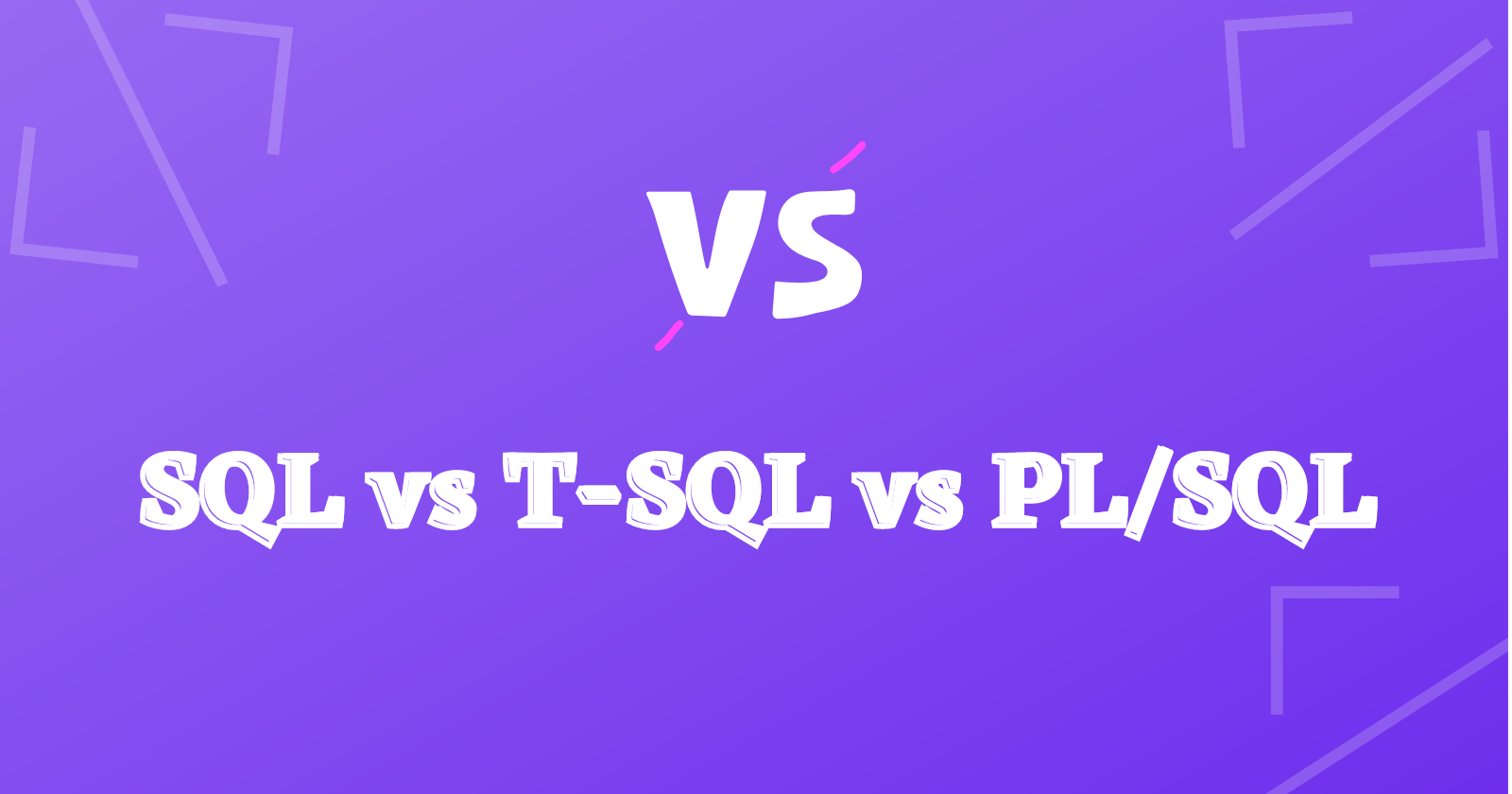SQL vs T-SQL vs PL/SQL
 Sarang S Babu
Sarang S Babu
Overview
SQL (Structured Query Language) is an ANSI standard adopted in 1986. Many RDBMS (relational database management system) vendors have used it as a foundation.
At the same time, PL/ SQL stands for Procedural Language Extensions SQL, an Oracle extension of Structured Query Language (SQL). T-SQL stands for Transact-SQL, which is Microsoft's and Sybase's extension to Structured Query Language (SQL).
What is SQL?
SQL or Structured Query Language is a standard language used to store, manipulate, and retrieve data from relational databases. Structured English Query Language, also known as SEQUEL, was the original name of SQL as given by IBM.
SQL is the database language that is used by all Relational Database Management Systems (RDMS), such as MySQL, MS Access, Oracle, Sybase, Informix, Postgres, and SQL Server. SQL is used to make a request for data retrieval from a database.
When a user makes a request for data, the DBMS processes the SQL query and returns the requested data to the user. SQL executes the commands such as Create, Drop, Insert, and so on.
What is T-SQL?
The acronym T-SQL stands for Transact Structure Query Language. It is a product that was developed by Microsoft and is an extension of the SQL Language, which is utilized to interact with relational databases.
It extends the functionality of SQL by allowing for the use of declared variables, transaction control, error and exception handling, and row processing.
It supports flow control with the keywords BEGIN and END, CONTINUE, BREAK, GOTO, IF-ELSE, WHILE, etc. Using the BULK INSERT statement, T-SQL allows you to insert numerous rows into a table by reading data from an external file. Using BULK INSERT instead of individual INSERT statements for every row that needs to be inserted improves performance.
When compared to PL-SQL, T-SQL has a different syntax. Nonetheless, it can accomplish the same functionality and produce similar outcomes as other languages.
What is PL/SQL?
PL/SQL stands for Procedural Language for SQL, which Oracle Corporation develops in the early 90s to improve SQL's functionalities.
It is a SQL language extension that combines SQL's data manipulation power with procedural language processing power to create super powerful SQL queries. The main advantages of PL/SQL are that it provides iteration, decision-making, and many other features.
PL/SQL programs are composed of blocks, which are the fundamental unit of PL/SQL. Variables, conditional statements, loops, arrays, and exceptions are all supported in PL/SQL. In a PL/SQL program, we can include some SQL statements such as SELECT, INSERT, DELETE, UPDATE, etc. CREATE, DROP, and ALTER are some SQL statements which is not permitted in PL/SQL program.
Some object-oriented programming concepts, such as function overloading, encapsulation, and information hiding, are also supported by PL/SQL. However, it does not support inheritance.
Difference between SQL and T-SQL
The main differences between SQL and T-SQL are as follows:
| SQL | T-SQL |
| SQL stands for Structured Query Language. | T-SQL is known as Transact Structure Query language. |
| It is not a procedural language. It executes one statement at a time. | It is a procedural language. It can execute many statements simultaneously by utilizing programming features such as looping and if-else statements. |
| It is an open-source query language. | It is owned and maintained by Microsoft. |
| We perform DML and DDL operations in Structured Query Language. | Transact Structured Query includes a code block for writing functions and procedures. |
| It is possible to embed SQL into TSQL. | It is not possible to embed T-SQL into SQL. |
| It is mostly used to alter and analyze a large amount of data through basic queries. | It is mainly used for creating application logic. |
Difference between SQL and PL/SQL
The main differences between SQL and PL/SQL are given below:
| SQL | PL/SQL |
| It is a declarative language. | It is a procedural language. |
| SQL only executes one statement at a time because it does not use programming features like looping and if-else statements. | PL/SQL can execute many statements simultaneously by utilizing programming features such as looping and if-else statements. |
| It is possible to embed SQL into PL/SQL. | It is not possible to embed PL/SQL into SQL. |
| There is interaction with the database server in SQL. | There is no interaction with the database server in PL/SQL. |
| This language is primarily data-oriented. | This language is primarily application-oriented. |
| SQL does not have variables. | Variables, data types, and other features are available in PL/SQL. |
Difference between T-SQL and PL/SQL
The main differences between T-SQL and PL/SQL are as follows:
| T-SQL | PL/SQL |
| Transact Structure Query Language is the full form of TL-SQL. | Procedural Language Structural Query Language is the full form of PL/SQL. |
| T-SQL is a product that was developed by Microsoft. | PL/SQL is a product that was developed by Oracle. |
| T-SQL is optimized for the Microsoft SQL Server. | PL/SQL is optimized for the Oracle database server. |
| T-SQL gives programmers more control over their data. | PL/SQL is a natural programming language that is very similar to SQL and offers more functionality. |
| DATETIME and SMALL-DATETIME are two data types available in T-SQL for dates. | The DATE is the only data type available in PL/SQL for dates. |
| NOT EXISTS is a clause utilized along with SELECT statements in T-SQL. | The MINUS operator can be used with SELECT statements in PL/SQL. |
| It is much simpler to understand and use. | It is considered more complex and powerful than T-SQL. |
| T-SQL requires the use of the SELECT INTO statement. | PL/SQL requires the use of the INSERT INTO statement. |
Conclusion
- SQL (Structured Query Language) is an ANSI standard adopted in 1986 and it is a standard language used to store, manipulate, and retrieve data from relational databases.
- Structured English Query Language, also known as SEQUEL, was the original name of SQL as given by IBM.
- The acronym T-SQL stands for Transact Structure Query Language. It is a product that was developed by Microsoft and is an extension of the SQL Language, which is utilized to interact with relational databases.
- PL/SQL stands for Procedural Language for SQL, which Oracle Corporation develops in the early 90s to improve SQL's functionalities. It is a SQL language extension that combines SQL's data manipulation power with procedural language processing power to create super powerful SQL queries.
- When compared to PL-SQL, T-SQL has a different syntax. Nonetheless, it can accomplish the same functionality and produce similar outcomes as other languages.
Subscribe to my newsletter
Read articles from Sarang S Babu directly inside your inbox. Subscribe to the newsletter, and don't miss out.
Written by

Sarang S Babu
Sarang S Babu
Hello, welcome to my space. I am a marketer by profession and a tech geek by passion.. In a continuous run to learn a new piece of stuff on the go.